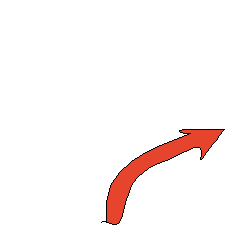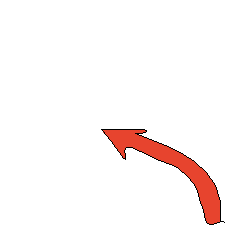

- Objects in motion of a rotating earth experience a deflection in their path associated with the Coriolis Effect, which varies in strength with latitude, causing the amount of deflection to increase towards the poles and decrease towrds the equator.
To grasp this concept, imagine a ball rolling across a slowly rotating merry-go-round. If you were standing next to (but not on) the merry-go-round, would the ball move in a straight line or a curved path?
The ball would follow a curved path, since for a given distance moving forward, the ball would also move to the side as a function of the rotation of the merry-go-round.

- In the northern hemisphere, objects in motion experience a deflection to the right (when looking in the direction of motion)
.
- At the equator, the Coriolis effect is absent, so there is no deflection of objects in motion.

- In the southern hemisphere, objects in motion experience a deflection to the left (when looking in the direction of motion)
.
.
- Let's put our ideas together, the combination of:
1. wind blowing away from high pressure and...............
2. a deflection in the direction of air motion due to the Coriolis effect,
resulting in a circular motion of air in the atmosphere
The prevailing wind systems of the earth blow from the several belts of high pressure toward adjacent low-pressure belts. Because of the earth's rotation (see Coriolis effect), the winds do not blow directly northward or southward to the area of lower pressure, but are deflected to the right in the Northern Hemisphere and to the left in the Southern Hemisphere. The wind systems comprise the trade winds; the prevailing westerlies, moving outward from the poleward sides of the horse-latitude belts toward the 60° latitude belts of low pressure (from the southwest in the Northern Hemisphere and from the northwest in the Southern Hemisphere); and the polar easterlies, blowing outward from the polar caps of high pressure and toward the 60° latitude belts of low pressure. This zonal pattern of winds is displaced northward and southward seasonally because of the inclination of the earth on its axis and the consequent migration of the belts of temperature and pressure. In addition, the pattern is considerably modified by the distribution of land and water, especially in the temperate regions, where temperature differences between land and water are greatest. In winter, areas of high pressure tend to build up over cold continental land masses, while low-pressure development takes place over the adjacent, relatively warm oceans. Exactly the opposite conditions occur during summer, although to a lesser degree. These contrasting pressures over land and water areas are the cause of monsoon winds.
Superimposed upon the general circulation of winds are many lesser disturbances, such as the extratropical cyclone (the common storm of the temperate latitudes), the tropical cyclone, or hurricane, and the tornado; each of these storms moves generally along a path that follows the direction of the prevailing winds but within itself maintains a circulatory wind pattern.
Furthur explination can be found at